layout: page title: “Intro to QIIME” comments: true date: 2016-07-13
Intro to QIIME for amplicon analysis¶
Authored by Ashley Shade, with contributions by Sang-Hoon Lee, Siobhan Cusack, Jackson Sorensen, and John Chodkowski. Modified by Adina Howe. Original tutorial is at EDAMAME-2016 wiki
Overarching Goal¶
- This tutorial will contribute towards an understanding of microbial amplicon analysis
Learning Objectives¶
- Execute a QIIME command: Assemble paired-end reads
- Execute a shell script to automate a process
- Explore input and output files for QIIME workflows and scripts
- Understand the structure and components of a good mapping file
- Move sequences into the QIIME environment from an outside tool using “add_qiime_labels.py”
- Obtain summary information about sequence files (fasta, fna, fastq)
- Define operational taxaonomic units (OTUs)
- Execute a QIIME workflow, and understand the separate steps in the workflow
- Align sequences, assign taxonomy, and build a tree with representative sequences from OTU definitions
1.1 Getting started¶
For this tutorial, we will be using the 16S rRNA gene sequencing data that has previously been generated. Let’s connect to our compute, and download our data.
wget https://s3.amazonaws.com/edamame/EDAMAME_16S.tar.gz
tar -zxvf EDAMAME_16S.tar.gz
One we’ve done that, we’ll navigate to the directory containing those files:
cd EDAMAME_16S/Fastq
You should see 108 files, all ending in .fastq.
1.2 Assembling Illumina paired-end sequences¶
These samples were sequenced using MiSeq 150 bp paired-end approach. Since the V4 region is only 253 bp long, our sequences should have ~50 bp of overlap. We can use this overlap to merge our 150 bp reads together to get the full 253 bp of the v4 region. Having longer reads gives us more information to work with when clustering reads into operational taxonomic units and for aligning these reads as well. The following steps go through how we accomplish this in QIIME.
1.2.1 Assembling paired-end reads.¶
join_paired_ends.py -f C01D01F_sub.fastq -r C01D01R_sub.fastq -o C01D01
The previous command works by calling the python script join_paired_ends.py and having it act on the forward and reverse reads for sample C01D01.
1.2.2 Sanity check and file inspection.¶
There are some questions you may be having: What files does this return? How many reads were successfully merged?
First let’s take a look at what the outputs of join_paired_ends.py.
cd C01D01
ls -lah
You’ll see three files here: fastqjoin.join.fastq, fastqjoin.un1.fastq, and fastqjoin.un2.fastq. fastqjoin.join.fastq contains all of the reads that were successfully merged, while fastqjoin.un1.fastq and fastqjoin.un2.fastq contain those reads which failed to merge form the forward and reverse files. Let’s have a look at our merged sequences.
head fastqjoin.join.fastq
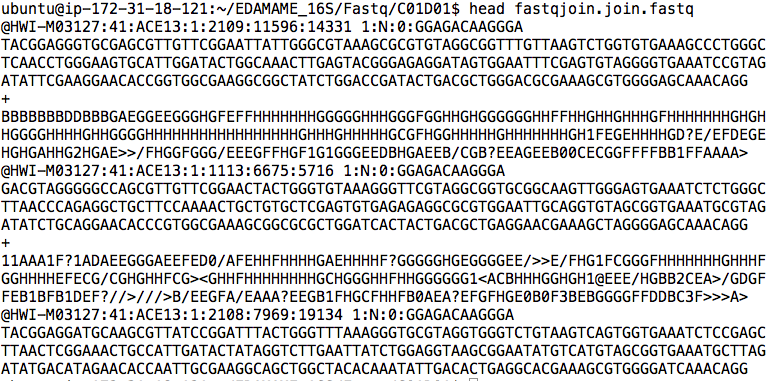
We see that the file is still in fastq format (ie there are 4 lines for each sequence beginning with a header line). We could go through an individually count every sequence that is there, or we could make use of grep and wc to automatically count.
grep '@HWI' fastqjoin.join.fastq | wc -l
The above command actually works in two steps. Everything before the | is searching for the string @HWI in our merged reads file fastq.join.fastq. We search for @HWI because every sequence header will start with this. The command after the | counts the number of lines from the output in the first half of the command. Therefore the command counts every single header of the sequences in the merged file which equals the total number of merged sequences. We see that the program managed to merge 7670 sequences.
We can double check our sanity by using a positive control. Let’s investigate how many sequences there were in the original unmerged files.
grep '@HWI' ../C01D01F_sub.fastq | wc -l
This returns 10,000. So our the program managed to merged about 75% of the reads. Just in case you aren’t convinced as to how this works lets go ahead and redirect the grep command to a new file instead of to the word count command.
grep '@HWI' fastqjoin.join.fastq > C01D01_MergedHeaders.txt
The > redirects the output of grep to a file instead of having every single result fly by on the screen. If you head the C01D01_MergedHeaders.txt file you’ll see the following.

Then feel free to use wc -l on this file to check the number of lines. The -l command in wc signifies that we want to count every line instead of every word.
wc -l C01D01_MergedHeaders.txt
The output is once again 7670. Hope you’re convinced now!
Next, we are going to automate the previous process so we don’t have to individually type in 54 lines of code. This means we need to clean up the directory for the sample we just did though. Move back a directory in the EDAMAME_16S/Fastq directory and execute the following command.
rm -r C01D01
1.2.3 Automate paired-end merging with a shell script.¶
We would have to execute an iteration of the join_paired_ends.py command for every pair of reads that need to be assembled. This could take a long time. So, we’ll use a shell script to automate the task.
To download the script and list onto the AMI, first navigate to the “Fastq” directory, use curl to get the files, and make a new Merged_Reads directory to put the merged reads into.
curl -O https://raw.githubusercontent.com/edamame-course/Amplicon_Analysis/master/resources/Merged_Reads_Script.sh
curl -O https://raw.githubusercontent.com/edamame-course/Amplicon_Analysis/master/resources/list.txt
mkdir Merged_Reads
Change permissions on the script to make it executable:
chmod 755 Merged_Reads_Script.sh
Execute the script from the Fastq Directory. Bonus: A great opportunity to try tmux!
./Merged_Reads_Script.sh
Bonus: A little about this shell script
For those of you interested in how this script works I recommend you take a look at it either through your terminal with less or online here. The script uses a “for loop” to repeat a set of commands for every single pair of files we have. For each sample the script first performs the merging with join_paired_ends.py and saves the output to a directory with the name of the sample. Secondly, because of some weird naming conventions the join_paired_ends.py function follows, the script renames and moves the resulting merged read files to a single directory each with their own name. Finally, the script removes the original directory that join_paired_ends.py as a cleanup step. This gets rid of 54 unnecessary directories making saving our instance space and our eyes the strain of having to look at them all everytime we want to ls in the directory.
1.2.4 Sanity check #2.¶
How many files were we expecting from the assembly? There were 54 pairs to be assembled, and we are generating one assembled fastq for each. Thus, the Merged_reads directory should contain 54 files. Navigate up one directory, and then use the wc (word count) command to check the number of files in the directory.
ls Merged_Reads | wc -l
The terminal should return the number “54”. Let’s move this whole directory up one level so that we can access more easily with QIIME:
mv Merged_Reads ..
Congratulations! You’ve assembled paired-end reads!
1.3 Understanding the QIIME mapping file¶
QIIME requires a mapping file for most analyses. This file is important because it links the sample IDs with their metadata (and, with their primers/barcodes if using QIIME for quality-control).
Let’s spend few moments getting to know the mapping file. Navigate to the MappingFiles subdirectory in the EDAMAME_16S/MappingFiles directory.
nano Centralia_Full_Map.txt
Warning We are using the text editor nano to look at the mapping file because it easier to view. However, as the description implies, you can use nano to alter files. Just make sure you exit the program without saving any chances by pressing ctrl+x. If you have made changes to the fils it will ask you if you want to save them, you do not, so type N and enter.
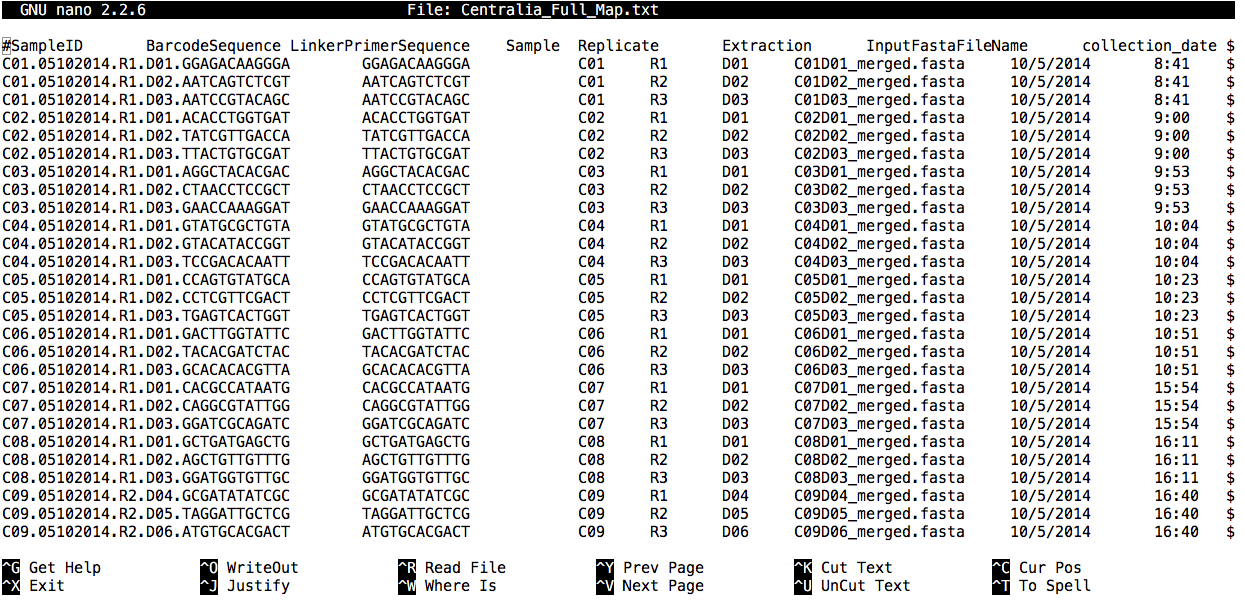
A clear and comprehensive mapping file should contain all of the information that will be used in downstream analyses. The mapping file includes both categorical (qualitative) and numeric (quantitative) contextual information about a sample. This could include, for example, information about the subject (sex, weight), the experimental treatment, time or spatial location, and all other measured variables (e.g., pH, oxygen, glucose levels). Creating a clear mapping file will provide direction as to appropriate analyses needed to test hypotheses. Basically, all information for all anticipated analyses should be in the mapping file.
Hint: Mapping files are also a great way to organize all of the data for posterity in the research group, and can provide a clear framework for making a database. New lab members interested in repeating the analysis should have all of the required information in the mapping file. PIs should ask their students to curate and deposit both mapping files and raw data files.
Guidelines for formatting map files:
- Mapping files should be tab-delimited
- The first column must be “#SampleIDs” (commented out using the
#). - SampleIDs are VERY IMPORTANT. Choose wisely! Ideally, a user who did not design the experiment should be able to distinguish the samples easily. In QIIME, SampleIDs must be alphanumeric characters or periods. They cannot have underscores.
- The last column must be “Description”.
- There can be as many in-between columns of contextual data as needed.
- If you plan to use QIIME for demultiplexing (which we do not need because the our reads already came demultiplexed from the facility), the BarcodeSequence and LinkerPrimer sequence columns are also needed, as the second and third columns, respectively.
- Excel can cause formatting heartache. See more details here.
1.4 Getting assembled reads into the one big data file, and extracting summary information¶
QIIME expects all of the data to be in one file, and, currently, we have one separate fastq file for each assembled read. We will add labels to each sample and merge into one fasta file using the add_qiime_labels.py script. Documentation is here.
Navigate back to the EDAMAME_16S/ directory, then execute the following command:
add_qiime_labels.py -i Merged_Reads/ -m MappingFiles/Centralia_Full_Map.txt -c InputFastaFileName -n 1
Inspect the new file “combined_seqs.fna.”
head combined_seqs.fna
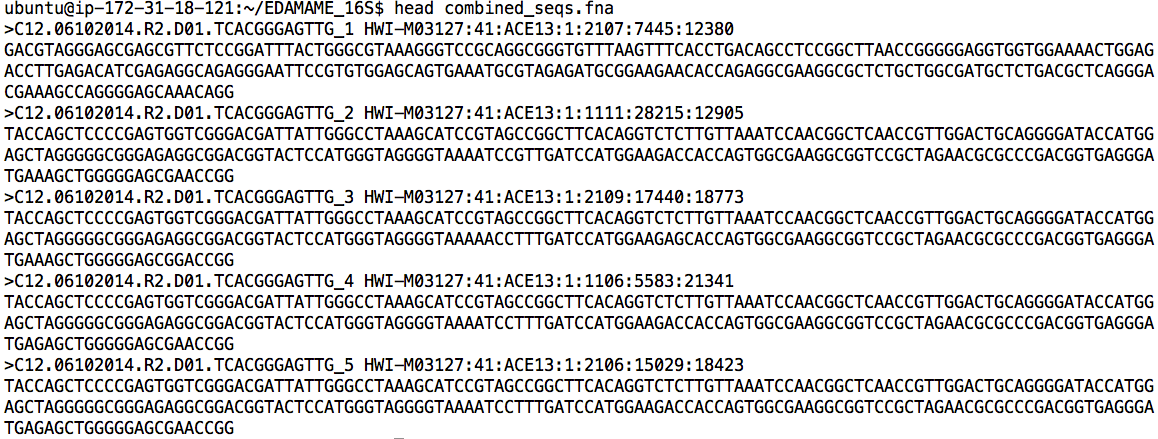
Observe that QIIME has added the SampleIDs from the mapping file to the start of each sequence. This allows QIIME to quickly link each sequence to its sampleID and metadata.
While we are inspecting the combined_seqs.fna file, let’s confirm how many sequences we have in the dataset.
count_seqs.py -i combined_seqs.fna
Looks like we have right around 442,289 sequences. This is a nice QIIME command to call frequently, because it provides the total number of sequences in a file, as well as some information about the lengths of those sequences. But, suppose we wanted to know more than the median/mean of these sequences?
1.5 Picking Operational Taxonomic Units, OTUs.¶
1.5.1 Preamble¶
Picking OTUs is sometimes called “clustering,” as sequences with some threshold of identity are “clustered” together to into an OTU.
Important decision: Should I use a de-novo method of picking OTUs or a reference-based method, or some combination? (Or not at all?). The answer to this will depend, in part, on what is known about the community a priori. For instance, a human or mouse gut bacterial community will have lots of representatives in well-curated 16S databases, simply because these communities are relatively well-studied. Therefore, a reference-based method may be preferred. The limitation is that any taxa that are unknown or previously unidentified will be omitted from the community. As another example, a community from a lesser-known environment, like Mars or a cave, or a community from a relatively less-explored environment would have fewer representative taxa in even the best databases. Therefore, one would miss a lot of taxa if using a reference-based method. The third option is to use a reference database but to set aside any sequences that do not have good matches to that database, and then to cluster these de novo.
For this tutorial, we are going to use an OTU-picking approach that uses a reference to identify as many OTUs as possible, but also includes any “new” sequences that do not hit the database. It is called “open reference” OTU picking, and you can read more about it in this paper by Rideout et al. Discussion of the workflow by the QIIME developers is here.
We use the QIIME workflow command: pick_open_reference_otus.py for this step. Documentation is here.
The default QIIME 1.9.1 method for OTU picking is uclust, which we use here for simplicity’s sake. However, we encourage you to explore different OTU clustering algorithms to understand how they perform. They are not created equal.
1.5.2 OTU picking¶
This next step will take about 45 minutes. Note: Use tmux!
The link explains tmux in more detail, but for now, execute the following:
tmux new -s OTUP
Before continuing, make sure you are in the “EDAMAME_16S” directory.
pick_open_reference_otus.py -i combined_seqs.fna -o uclust_openref/ -f
In the above script:
- We tell QIIME to look for the input file
-i, “combined_seqs.fna”. - We specify that output files should go in a new folder, uclust_openref/
- We tell the program to overwrite already-existing files in the folder if we are running this program more than once (-f)
Other default parameters of interest:
- Singletons are removed from the OTU table (default flag –min_otu_size)
- Alignment is performed with PyNAST
- Taxonomy is assigned with uclust
- Default workflow values can be changed using a parameter file
- We do not perform prefiltering, as per the recommendations of Rideout et al.
Finally, we need to exit tmux:
ctrl+b d
Bonus Material¶
1.5.3 Exploring results from OTU picking workflow¶
#####”Steps” from open reference picking
In uclust_openref/, we can see several new directories and files. Let’s explore them, starting with the “step1..” directories. As the documentation for pick_open_reference_otus.py explains:
- Step 1 picks OTUs based on a reference database, producing a file of successfully clustered OTUs and a file of sequences that failed to cluster based on the reference database.
- Step 2 performs computationally expensive de novo clustering for a subset of the failed sequences from step 1, and picks a representative sequence from each new cluster to add to the original database.
- Step 3 picks OTUs from all of the failed sequences, not just the subset used in step 2, based on the new database generated (of ref+ de novos) in step 2.
- Step 4 performs de novo clustering on all remaining OTUs.
An great overview of the steps of the open-reference process is provided by Figure 1 of Rideout et al. 2014.
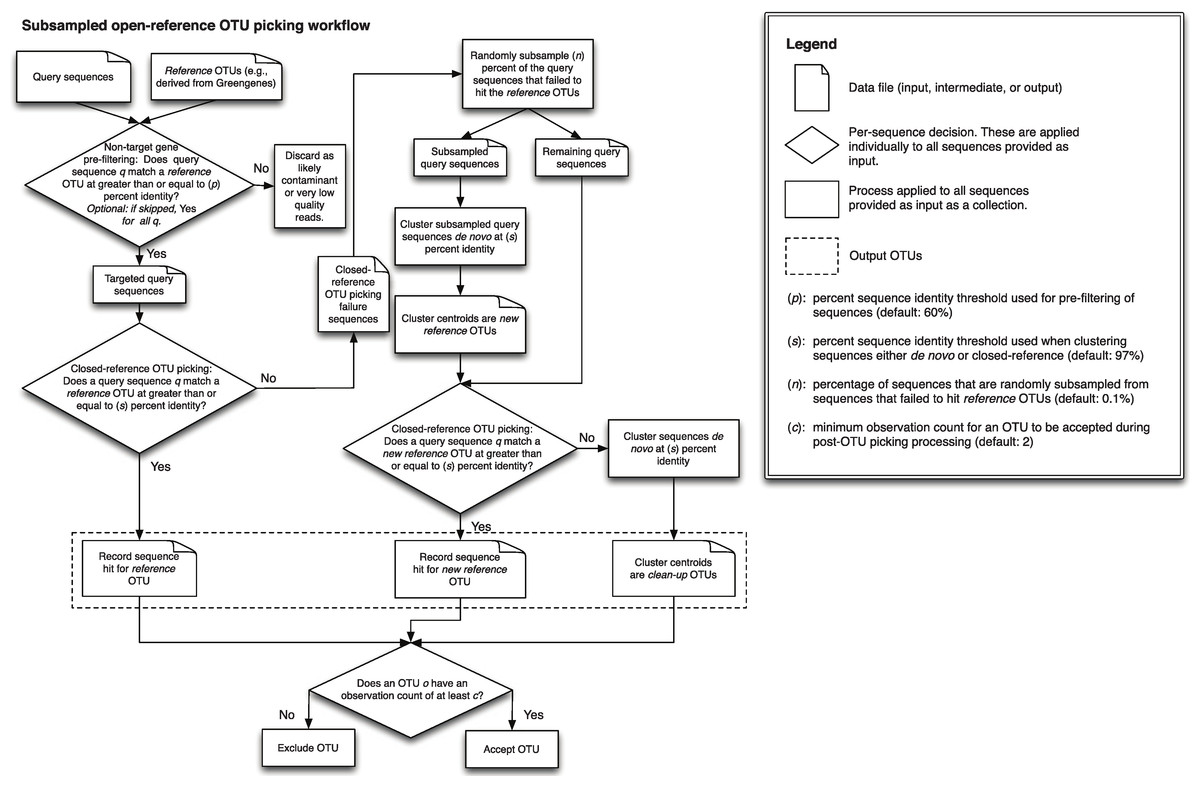
If you navigate into one of the “step” directories, you will see a series of output files, including representative sequences of OTU clusters (“rep_set”). Take your time to explore these files using the head or less commands. Then, navigate back to the uclust_openrefs directory.
What are the other directories? The open reference OTU picking also automatically takes the next steps towards building the OTU table. The pynast_aligned_seqs directory and the uclust_assigned_taxonomy each have outputs and logs from alignments and taxonomic assignment, respectively. Notice that the directories are named so that the algorithm/tool used to perform the task is provided (e.g., pynast was used for alignment, uclust was used for taxonomy). Very smart!
Alignment output¶
Navigate into the pynast_aligned_seq directory directory. There are four files waiting there: one file of sequences that failed to align, one of sequences that did align, one of “pre-alignment” files, and a log file. Inspect each.
If you want to build a tree with some other out-of-QIIME software, this is where you would find the rep_set alignment. The log file provides a rep-sequence by rep-sequence report. If you needed align sequences as an independent step, you would use align_seqs.py; documentation here.
How many failed alignments were there?
count_seqs.py -i rep_set_failures.fasta
We see that there were 690 rep. sequences that failed to align, and approximately 22,206 that did. (Also, notice what short-read alignments generally look like...not amazing).
Taxonomy files¶
Move up a directory and then cd into the uclust_assigned_taxonomy directory.
more rep_set_tax_assignments.txt
In the “taxonomy” directory, you will find a log file and the specific taxonomic assignments given to each representative sequence, linked to the OTU ID of that representative sequence
#####Other Very Important Files in uclust_openref/ ######OTU map
nano final_otu_map.txt
Explore this file. It links the exact sequences in each sample to its OTU ID. You should see an OTU ID (starting with the number of the first OTU that was picked) in the the left most column. After that number, there is a list of Sequence IDs that have been clustered into that OTU ID. The first part of the sequence ID is the SampleID from which it came, and the second part is the sequence number within that sample.
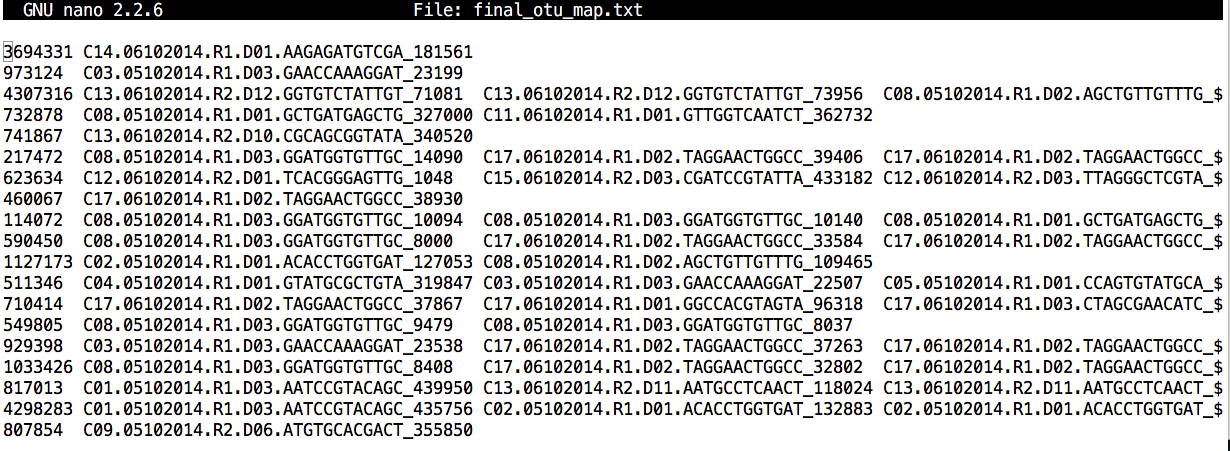
You will notice that some files have “mc2” appended to them. “mc2” designates that the minimum count of sequences for any particular OTU was 2. In other words, that file has singleton OTUs already filtered out.
Sanity check: How can you compare the OTUs in the full dataset versus the singletons-omitted dataset?
Biom-formatted OTU tables¶
These tables have the extension ”.biom” There are lots of important resources for understanding and working with the “biome” formatted tables, which were developed to deal with very large, sparse datasets, like those for microbial communities. There are several versions - some omitting singletons (mc2), some containing taxonomic assignment of otus (w_tax), some omitting alignment failures (no_pynast_failures). Biom-formatted tables are actually a binary file, so looking at it with less or more won’t be informative.
Representative sequences (one from each OTU)¶
more rep_set.fna
This is not an alignment, but the list of representative sequences used to assign taxonomy to the OTU, to make the alignment, and to build the tree.
Log files¶
Open them up! You will be delighted! It has all of the information you ever wanted to know about the parameters and tools you’ve just used for your workflow analysis! Hint: most of this information is needed when writing the methods sections of manuscripts using sequencing data.
Resources and help¶
QIIME¶
- QIIME offers a suite of developer-designed tutorials.
- Documentation for all QIIME scripts.
- There is a very active QIIME Forum on Google Groups. This is a great place to troubleshoot problems, responses often are returned in a few hours!
- The QIIME Blog provides updates like bug fixes, new features, and new releases.
- QIIME development is on GitHub.
- Remember that QIIME is a workflow environment, and the original algorithms/software that are compiled into QIIME must be referenced individually (e.g., PyNAST, RDP classifier, FastTree etc...)